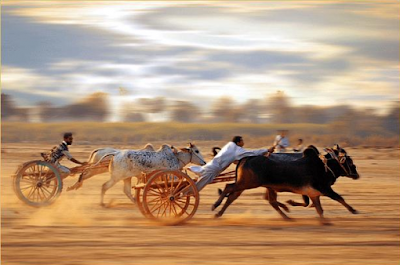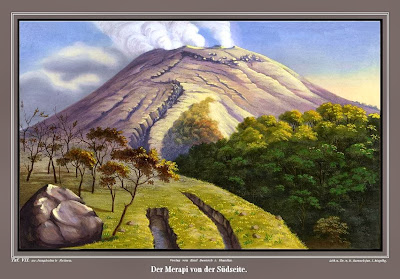Karapan Sapi is a name given to a race of cows. The karapan sapi takes place in Madura island, the northeast from Java Island. In this race, several man are riding a pair of racing cow. And is is held on a dusted land. It is one of the most unique show i ever heard. Imagine a cow that is usually used to get the milked and here is become a racing machine. The track of this race is about 100meter. It is about the size of a football field. The match is held on August until October yearly held here in Madura. The show is accompanied by music called Madura'sgamelan called Saronen. Come to visit Indonesia and see the amazing karapan sapi on madura Island of Indonesia. Feel the excitement of Karapan Sapi with your very own eyes.
Minggu, 27 November 2011
Karapan Sapi, Madura
Label:
cow race,
cow race Indonesia,
karapan sapi,
madura,
race,
sapi
Sabtu, 26 November 2011
Semeru
Semeru is a nice volcano and also one of the most favourite hiking place in Indonesia. Here you can see a beautiful mountain with beautiful view too. You can see several mountain here. Semeru weather is good too.
Semeru, or Mount Semeru (Indonesian: Gunung Semeru), is a volcano located in East Java, Indonesia. It is the highest mountain on the island of Java. The stratovolcano is also known as Mahameru, meaning 'The Great Mountain.[1] The name derived from Hindu-Buddhist mythical mountain of Meru or Sumeru, the abode of gods.
You also must be careful because it is still an active volcano. Watch out for its eruption. Several months ago this mountain spout some hot clouds.
Semeru is named from Sumeru, the central world-mountain in Buddhist cosmology and by extension Hinduism. As stated in legend, it was transplanted from India; the tale is recorded in the 15th-century East Javanese work Tantu Pagelaran. It was originally placed in the western part of the island, but that caused the island to tip, so it was moved eastward. On that journey, parts kept coming off the lower rim, forming the mountains Lawu, Wilis, Kelut, Kawi, Arjuno and Welirang. The damage thus caused to the foot of the mountain caused it to shake, and the top came off and created Penanggungan as well
Enjoy trip to Semeru, and also come to another place in this country, like Bali or Yogyakarta.
Semeru, or Mount Semeru (Indonesian: Gunung Semeru), is a volcano located in East Java, Indonesia. It is the highest mountain on the island of Java. The stratovolcano is also known as Mahameru, meaning 'The Great Mountain.[1] The name derived from Hindu-Buddhist mythical mountain of Meru or Sumeru, the abode of gods.
You also must be careful because it is still an active volcano. Watch out for its eruption. Several months ago this mountain spout some hot clouds.
Semeru is named from Sumeru, the central world-mountain in Buddhist cosmology and by extension Hinduism. As stated in legend, it was transplanted from India; the tale is recorded in the 15th-century East Javanese work Tantu Pagelaran. It was originally placed in the western part of the island, but that caused the island to tip, so it was moved eastward. On that journey, parts kept coming off the lower rim, forming the mountains Lawu, Wilis, Kelut, Kawi, Arjuno and Welirang. The damage thus caused to the foot of the mountain caused it to shake, and the top came off and created Penanggungan as well
Enjoy trip to Semeru, and also come to another place in this country, like Bali or Yogyakarta.
Rabu, 23 November 2011
Ancol
Ancol is one of my favourite tourism place in jakarta. It have a nice beach with a nice view. You can watch sunset or you can also play in the water park.
Ancol is an Administrative Village (Kelurahan) in Pademangan Subdistrict, North Jakarta, Jakarta. It is located in the coastal lowland of Jakarta. Ancol is bounded by Jakarta Bay to the north, Sunda Kelapa harbor to the west, and Kali Japat canal to the east. Ancol has the area code of 14430.
Ancol contains the main beach resort of Jakarta. Taman Impian Jaya Ancol, the largest integrated tourism area in South East Asia, is located in Ancol.
Ancol has been variously known in history as Anciol, Angiol, Anschiol, Ansjol, Antsyol, Anjool.
Ancol is also usually be the place of an interesting event, like music concert or party.
The name Ancol was first mentioned in Koropak 406, a palm leaf manuscript written in late 16th century. It stated the attempt of the Sultanate of Banten, Cirebon, and Demak to siege Sunda Kelapa, and that the area of Ancol is considered an important area to attack Sunda Kelapa from the east:
…Disilihan inya ku prebu Surawisesa, iny nu surup ka padaren, kasuran, kadiran, kuwamen. Prangrang lima welas kali hanteu eleh, ngalakukeun bala sariwu. Prangrang ka Kalapa deung Aaria burah. Prangrang ka Tanjung. Prangrang ka Ancol kiyi….
According to Indonesian National Dictionary (Kamus Besar Bahasa Indonesia), the word Ancol has the same meaning as the word Tanjung, which means "a body of land extending into a body of water / a cape".
Ancol is an Administrative Village (Kelurahan) in Pademangan Subdistrict, North Jakarta, Jakarta. It is located in the coastal lowland of Jakarta. Ancol is bounded by Jakarta Bay to the north, Sunda Kelapa harbor to the west, and Kali Japat canal to the east. Ancol has the area code of 14430.
Ancol contains the main beach resort of Jakarta. Taman Impian Jaya Ancol, the largest integrated tourism area in South East Asia, is located in Ancol.
Ancol has been variously known in history as Anciol, Angiol, Anschiol, Ansjol, Antsyol, Anjool.
Ancol is also usually be the place of an interesting event, like music concert or party.
The name Ancol was first mentioned in Koropak 406, a palm leaf manuscript written in late 16th century. It stated the attempt of the Sultanate of Banten, Cirebon, and Demak to siege Sunda Kelapa, and that the area of Ancol is considered an important area to attack Sunda Kelapa from the east:
…Disilihan inya ku prebu Surawisesa, iny nu surup ka padaren, kasuran, kadiran, kuwamen. Prangrang lima welas kali hanteu eleh, ngalakukeun bala sariwu. Prangrang ka Kalapa deung Aaria burah. Prangrang ka Tanjung. Prangrang ka Ancol kiyi….
According to Indonesian National Dictionary (Kamus Besar Bahasa Indonesia), the word Ancol has the same meaning as the word Tanjung, which means "a body of land extending into a body of water / a cape".
Minggu, 20 November 2011
Mother Temple of Besakih
Several years ago i ever go to besakih, it is so amazing, that the people there is so serious on praying. It is wonderful temple in Indonesia, in Bali. It is near Kuta Bali and you mus go to Besakih if you trip to Bali
The Mother Temple of Besakih, or Pura Besakih, in the village of Besakih on the slopes of Mount Agung in eastern Bali, is the most important, the largest and holiest temple of Agama Hindu Dharma in Bali, Indonesia and one of a series of Balinese temples.
The temple is actually a complex made up of twenty-two temples that sit on parallel ridges. It has stepped terraces and flights of stairs which ascend to a number of courtyards and brick gateways that lead up to the main spire Meru structure, which is called Pura Penataran Agung. All this is aligned along a single axis and designed to lead the spiritual upward and closer to the mountain which is considered sacred.
The symbolic center or main sanctuary of the complex is the Pura Penataran Agung and and the lotus throne or padmasana is the symbolic center of the main sanctuary and ritual focus of the entire complex. It dates to around the seventeenth century.
A series of eruptions of Mount Agung in 1963, which killed approximately 1,700 people also threatened Puru Besakih. The lava flows missed the temple complex by mere meters. The saving of the temple is regarded by the Balinese people as miraculous, and a signal from the gods that they wished to demonstrate their power but not destroy the monument the Balinese faithful had erected.
The Mother Temple of Besakih, or Pura Besakih, in the village of Besakih on the slopes of Mount Agung in eastern Bali, is the most important, the largest and holiest temple of Agama Hindu Dharma in Bali, Indonesia and one of a series of Balinese temples.
The temple is actually a complex made up of twenty-two temples that sit on parallel ridges. It has stepped terraces and flights of stairs which ascend to a number of courtyards and brick gateways that lead up to the main spire Meru structure, which is called Pura Penataran Agung. All this is aligned along a single axis and designed to lead the spiritual upward and closer to the mountain which is considered sacred.
The symbolic center or main sanctuary of the complex is the Pura Penataran Agung and and the lotus throne or padmasana is the symbolic center of the main sanctuary and ritual focus of the entire complex. It dates to around the seventeenth century.
A series of eruptions of Mount Agung in 1963, which killed approximately 1,700 people also threatened Puru Besakih. The lava flows missed the temple complex by mere meters. The saving of the temple is regarded by the Balinese people as miraculous, and a signal from the gods that they wished to demonstrate their power but not destroy the monument the Balinese faithful had erected.
Sabtu, 19 November 2011
Manado
Manado in Indonesia is famous for its dance. Here everyone is doing party as often as possible. Here you will enjoy the dance culture
Manado (pronounced [məˈnado]) is the capital of the North Sulawesi province of Indonesia. Manado is located at the Bay of Manado, and is surrounded by a mountainous area. The city has about 405,715 inhabitants, making it the second-largest city in Sulawesi after Makassar. The municipality of Manado is divided into nine districts: Malalayang, Sario, Wanea, Tikala, Wenang, Mapanget, Singkil, Tuminting and Bunaken.
As the largest city in the region, Manado is a key tourist transit point for visitors. Sam Ratulangi International Airport of Manado is one of the main entry ports to Indonesia. In 2005, no less than 15,000 international passengers entered Indonesia via Sam Ratulangi International Airport.
Manado is also home to some of the biggest and most influential churches in the province, with many of them located along the iconic Sam Ratulangi Street. Ecotourism is the biggest attraction in Manado.
Scuba diving and snorkelling on the nearby Bunaken National Park, including the island of Bunaken are popular attractions.[9][10][11]
Ban Hin Kiong Temple is another tourism spot in the city, especially during the Chinese new year celebration. Souvenirs shops are located on B.W. Lapian street.
Other places of interest are nearby Lake Tondano, Lake Linow, Lokon Volcano, Klabat Volcano and Mahawu Volcano.
Citraland, a wealthy suburb of Manado, is home to Asia's 2nd tallest and the world's 4th tallest statue of Christ (Christ Blessing Statue), and perhaps the world's first statue in the flying posture.
Wakeke Street, somewhere on the middle of the town, was resolved by the local government as culinary tourism area for tinutuan or bubur manado, that is manadonese porridge. Indonesia's only active synagogue is in Manado.
Manado (pronounced [məˈnado]) is the capital of the North Sulawesi province of Indonesia. Manado is located at the Bay of Manado, and is surrounded by a mountainous area. The city has about 405,715 inhabitants, making it the second-largest city in Sulawesi after Makassar. The municipality of Manado is divided into nine districts: Malalayang, Sario, Wanea, Tikala, Wenang, Mapanget, Singkil, Tuminting and Bunaken.
As the largest city in the region, Manado is a key tourist transit point for visitors. Sam Ratulangi International Airport of Manado is one of the main entry ports to Indonesia. In 2005, no less than 15,000 international passengers entered Indonesia via Sam Ratulangi International Airport.
Manado is also home to some of the biggest and most influential churches in the province, with many of them located along the iconic Sam Ratulangi Street. Ecotourism is the biggest attraction in Manado.
Scuba diving and snorkelling on the nearby Bunaken National Park, including the island of Bunaken are popular attractions.[9][10][11]
Ban Hin Kiong Temple is another tourism spot in the city, especially during the Chinese new year celebration. Souvenirs shops are located on B.W. Lapian street.
Other places of interest are nearby Lake Tondano, Lake Linow, Lokon Volcano, Klabat Volcano and Mahawu Volcano.
Citraland, a wealthy suburb of Manado, is home to Asia's 2nd tallest and the world's 4th tallest statue of Christ (Christ Blessing Statue), and perhaps the world's first statue in the flying posture.
Wakeke Street, somewhere on the middle of the town, was resolved by the local government as culinary tourism area for tinutuan or bubur manado, that is manadonese porridge. Indonesia's only active synagogue is in Manado.
Jumat, 18 November 2011
Merapi Volcano, Yogyakarta
Mount Merapi, Gunung Merapi (literally Fire Mountain in Indonesian/Javanese), is an active stratovolcano located on the border between Central Java and Yogyakarta, Indonesia. It is the most active volcano in Indonesia and has erupted regularly since 1548. It is located approximately 28 kilometres (17 mi) north of Yogyakarta city, and thousands of people live on the flanks of the volcano, with villages as high as 1,700 metres (5,600 ft) above sea level.
The name Merapi could be loosely translated as 'Mountain of Fire'. The etymology of the name came from Meru-Api; from the Javanese combined words; Meru means "mountain" refer to mythical mountain of Gods in Hinduism, and api means "fire". Smoke can be seen emerging from the mountaintop at least 300 days a year, and several eruptions have caused fatalities. Hot gas from a large explosion killed 27 people on 22 November in 1994, mostly in the town of Muntilan, west of the volcano. Another large eruption occurred in 2006, shortly before the Yogyakarta earthquake. In light of the hazards that Merapi poses to populated areas, it has been designated as one of the Decade Volcanoes.
On 25 October 2010 the Indonesian government raised the alert for Mount Merapi to its highest level and warned villagers in threatened areas to move to safer ground. People living within a 20 km (12 mi) zone were told to evacuate. Officials said about 500 volcanic earthquakes had been recorded on the mountain over the weekend of 23–24 October, and that the magma had risen to about 1 kilometre (3,300 ft) below the surface due to the seismic activity. On the afternoon of 25 October 2010 Mount Merapi erupted lava from its southern and southeastern slopes.
The mountain was still erupting on 30 November 2010 however due to lowered eruptive activity on 3 December 2010 the official alert status was reduced to level 3. The volcano is now 2930 metres high, 38 metres lower than before the 2010 eruptions
Kamis, 17 November 2011
National Monument, Indonesia Jakarta
The National Monument (Indonesian: Monumen Nasional (Monas)) is a 433 ft (132 metre) tower in the centre of Merdeka Square, Central Jakarta, symbolizing the fight for Indonesia's independence. Construction began in 1961 under the direction of President Sukarno and the monument was opened to the public in 1975. It is topped by a flame covered with gold foil. The monument and the museum is open daily from 08.00 - 15.00 Western Indonesia Time (UTC+7), everyday throughout the week, except for the last Monday of each month, when the monument is closed. In NAtionl Monument, we can see a lot of things, like war environment.
Rabu, 16 November 2011
Tanjung Benoa - Bali
Tanjung Benoa is one of my favourite tourism place in Indonesia. You can dive there, also can watch turtle, or raiding boat, fly with some boats.
Immediately north of Nusa Dua enclave is the peninsula of Tanjung Benoa that includes less exclusive hotels and Benoa village. A multi-denominational area, it includes a mosque, and Chinese and Hindu temples in close proximity. Much of the beach's sand was eroded away following the mining of the nearby barrier reef for construction materials. Benoa Harbour is also located here for yachts and small ships.
Nusa Dua is known as an enclave of large international 5-star resorts in south-eastern Bali. It is located 40 kilometres from Denpasar, the provincial capital of Bali, and administered under Kuta South District. Nusa Dua means two islands.
Selasa, 15 November 2011
Toba Lake, Sumatera Utara
Lake Toba (Indonesian: Danau Toba) is a lake and supervolcano. The lake is 100 kilometres long and 30 kilometres wide, and 505 metres (1,666 ft) at its deepest point. Located in the middle of the northern part of the Indonesian island of Sumatra with a surface elevation of about 900 metres (2,953 ft), the lake stretches from 2°53′N 98°31′E / 2.88°N 98.52°E / 2.88; 98.52 to 2°21′N 99°06′E / 2.35°N 99.1°E / 2.35; 99.1. It is the largest lake in Indonesia and the largest volcanic lake in the world.
Lake Toba is the site of a supervolcanic eruption that occurred 69,000–77,000 years ago, a massive, climate-changing event. The eruption is believed to have had a VEI intensity of 8. It is believed to be the largest explosive eruption anywhere on Earth in the last 25 million years. According to the Toba catastrophe theory to which some anthropologists and archeologists subscribe, it had global consequences, killing most humans then alive and creating a population bottleneck in Central Eastern Africa and India that affected the genetic inheritance of all humans today.[5] However, this theory has been the subject of considerable debate due to lack of evidence for any other animal decline or extinction, even in environmentally sensitive species. However, it has been accepted that the eruption of Toba led to a volcanic winter with a worldwide decline in temperatures between 3 to 5 °C (5 to 9 °F), and up to 15 °C (27.0 °F) in higher latitudes.
Senin, 14 November 2011
Bunaken, A Wonderful Diving Place
Bunaken is an island of 8 km², part of the Bunaken National Marine Park. Bunaken is located at the northern tip of the island of Sulawesi, Indonesia. It belongs administratively to the municipality of Manado. Scuba diving attracts many visitors to the island.
Other sides of Bunaken.
Bunaken National Park extends over an area of 890.65 km² of which only 3% is terrestrial, including Bunaken Island, as well as the islands of Manado Tua, Mantehage, Nain and Siladen.
The waters of Bunaken National Marine Park are up to 1,566 m deep in Manado Bay, with temperatures ranging between 27 to 29 °C. It has a high diversity of - corals, fish, echinoderms or sponges. Notably, 7 of the 8 species of giant clams that occur in the world, occur in Bunaken. It also claims to have seven times more genera of coral than Hawaii, and has more than 70% of all the known fish species of the Indo-Western Pacific.
Oceanic currents may explain, in part, why Bunaken National Marine Park has such a high level of biodiversity. Northeasternly currents generally sweep through the park but abundant counter currents and gyros related to lunar cycles are believed to be a trap for free swimming larvae. This is particularly true on the south side of the crescent-shaped Bunaken Island, lying in the heart of the park. A snorkeler or diver in the vicinity of Lekuan or Fukui may spot over 33 species of butterfly fish and numerous types of groupers, damsels, wrasses and gobies. The gobies, smallish fish with bulging eyes and modified fins that allow them to attach to hard surfaces, are the most diverse but least known group of fish in the park.
Other sides of Bunaken.
Bunaken National Park extends over an area of 890.65 km² of which only 3% is terrestrial, including Bunaken Island, as well as the islands of Manado Tua, Mantehage, Nain and Siladen.
The waters of Bunaken National Marine Park are up to 1,566 m deep in Manado Bay, with temperatures ranging between 27 to 29 °C. It has a high diversity of - corals, fish, echinoderms or sponges. Notably, 7 of the 8 species of giant clams that occur in the world, occur in Bunaken. It also claims to have seven times more genera of coral than Hawaii, and has more than 70% of all the known fish species of the Indo-Western Pacific.
Oceanic currents may explain, in part, why Bunaken National Marine Park has such a high level of biodiversity. Northeasternly currents generally sweep through the park but abundant counter currents and gyros related to lunar cycles are believed to be a trap for free swimming larvae. This is particularly true on the south side of the crescent-shaped Bunaken Island, lying in the heart of the park. A snorkeler or diver in the vicinity of Lekuan or Fukui may spot over 33 species of butterfly fish and numerous types of groupers, damsels, wrasses and gobies. The gobies, smallish fish with bulging eyes and modified fins that allow them to attach to hard surfaces, are the most diverse but least known group of fish in the park.
Minggu, 13 November 2011
Yogyakarta, The Beautiful Culture
Yogyakarta is one of the many tourism object in Indonesia. It is in the Java Island, is about 1 hour from bali with plane. You can see so many tourism place here, like Malioboro, Kraton(Palace): Here there is a king named Sri Sultan, Parangtritis, Benteng Vredeburg(near Malioboro), Candi Prambanan, Monumen Jogja Kembali, and so many others. You will be in pleasure here, enjoy Jogja!
Kuta, Bali
Kuta is administratively a district (kecamatan) and subdistrict/village (kelurahan) in southern Bali, Indonesia. A former fishing village, it was one of the first towns on Bali to see substantial tourist development, and as a beach resort remains one of Indonesia's major tourist destinations. It is known internationally for its long sandy beach, varied accommodation, many restaurants and bars, and many renowned surfers who visit from Australia. It is located near Bali's Ngurah Rai Airport.
Kuta was the site of the October 12, 2002 1st Bali bombing (202 killed) and the October 1, 2005 2nd Bali bombing (26 killed).
The Balinese Provincial Government have taken the view that the preservation of the Balinese culture, natural resources and wildlife are of primary importance in the development of the island. To this end they have limited tourist development to the peninsula on the extreme southern aspect of the island; Kuta beach is on the western side of this peninsula and Sanur is on the east. To the north of the peninsula no new tourist development is supposedly permitted.[citation needed].
To the south, Kuta Beach extends beyond the airport into Jimbaran. Other nearby towns and villages include Seseh (6.4 nm), Denpasar (4.5 nm), Ujung (1.8 nm), Pesanggaran (2.0 nm), Kedonganan (2.9 nm) and Tuban (1.0 nm).
Kuta was the site of the October 12, 2002 1st Bali bombing (202 killed) and the October 1, 2005 2nd Bali bombing (26 killed).
The Balinese Provincial Government have taken the view that the preservation of the Balinese culture, natural resources and wildlife are of primary importance in the development of the island. To this end they have limited tourist development to the peninsula on the extreme southern aspect of the island; Kuta beach is on the western side of this peninsula and Sanur is on the east. To the north of the peninsula no new tourist development is supposedly permitted.[citation needed].
To the south, Kuta Beach extends beyond the airport into Jimbaran. Other nearby towns and villages include Seseh (6.4 nm), Denpasar (4.5 nm), Ujung (1.8 nm), Pesanggaran (2.0 nm), Kedonganan (2.9 nm) and Tuban (1.0 nm).
Candi Prambanan
Prambanan is a ninth century Hindu temple compound in Central Java, Indonesia, dedicated to the Trimurti, the expression of God as the Creator (Brahma), the Sustainer (Vishnu) and the Destroyer (Shiva). The temple compound is located approximately 18 km east of Yogyakarta city on the boundary between Yogyakarta and Central Java province.
The temple, a UNESCO World Heritage Site, is the largest Hindu temple in Indonesia, and is one of the largest and the most beautiful Hindu temples in Southeast Asia. It is characterized by its tall and pointed architecture, typical of Hindu temple architecture, and by the towering 47m high central building inside a large complex of individual temples. One of the most majestic temples in the Southeast Asia, Prambanan attracts many visitors worldwide.
The temple, a UNESCO World Heritage Site, is the largest Hindu temple in Indonesia, and is one of the largest and the most beautiful Hindu temples in Southeast Asia. It is characterized by its tall and pointed architecture, typical of Hindu temple architecture, and by the towering 47m high central building inside a large complex of individual temples. One of the most majestic temples in the Southeast Asia, Prambanan attracts many visitors worldwide.
Sabtu, 12 November 2011
Jakarta
Jakarta (English pronunciation: /dʒəˈkɑrtə/[ formerly Batavia) is the capital and largest city of Indonesia. Officially known as the Special Capital Territory of Jakarta, it is located on the northwest coast of Java, has an area of 661 square kilometres (255 sq mi), and a population of 9,580,000. Jakarta is the country's economic, cultural and political centre. It is the most populous city in Indonesia and in Southeast Asia, and is the tenth-largest city in the world. The urban area, Jabodetabek, is the second largest in the world. Jakarta is listed as a global city in the 2008 Globalization and World Cities Study Group and Network (GaWC) research.
Established in the fourth century, the city became an important trading port for the Kingdom of Sunda. It was the de facto capital of the Dutch East Indies (when it was known as "Batavia") and has continued as the capital of Indonesia since the country's independence was declared in 1945.
The city is the seat of the ASEAN Secretariat. Jakarta is served by the Soekarno-Hatta International Airport, Halim Perdanakusuma International Airport, and Tanjung Priok Harbour; it is connected by several intercity and commuter railways, and served by several bus lines running on reserved busways.
Established in the fourth century, the city became an important trading port for the Kingdom of Sunda. It was the de facto capital of the Dutch East Indies (when it was known as "Batavia") and has continued as the capital of Indonesia since the country's independence was declared in 1945.
The city is the seat of the ASEAN Secretariat. Jakarta is served by the Soekarno-Hatta International Airport, Halim Perdanakusuma International Airport, and Tanjung Priok Harbour; it is connected by several intercity and commuter railways, and served by several bus lines running on reserved busways.
Jumat, 11 November 2011
Bali
Bali is an Indonesian island located in the westernmost end of the Lesser Sunda Islands, lying between Java to the west and Lombok to the east. It is one of the country's 33 provinces with the provincial capital at Denpasar towards the south of the island (strictly speaking, the province covers a few small neighbouring islands as well as the isle of Bali).
With a population recorded as 3,891,000 in the 2010 Census, the island is home to most of Indonesia's small Hindu minority. In the 2000 census about 92.29% of Bali's population adhered to Balinese Hinduism while most of the remainder follow Islam. It is also the largest tourist destination in the country and is renowned for its highly developed arts, including traditional and modern dance, sculpture, painting, leather, metalworking, and music. Bali, a tourist haven for decades, has seen a further surge in tourist numbers in recent years.
With a population recorded as 3,891,000 in the 2010 Census, the island is home to most of Indonesia's small Hindu minority. In the 2000 census about 92.29% of Bali's population adhered to Balinese Hinduism while most of the remainder follow Islam. It is also the largest tourist destination in the country and is renowned for its highly developed arts, including traditional and modern dance, sculpture, painting, leather, metalworking, and music. Bali, a tourist haven for decades, has seen a further surge in tourist numbers in recent years.
Senin, 07 November 2011
Keris
The kris or keris is an asymmetrical dagger or sword nowadays most strongly associated with the culture of Indonesia, but also indigenous to Malaysia, Southern Thailand and Brunei. It is known as kalis in the southern Philippines. The kris is famous for its distinctive wavy blade (luk), but many have straight blades as well. The numbers of luks is always odd numbered, ranged from three to thirteen waves, however there is also luks that reach 29. Kris can be divided into three parts: wilah (blade), hulu (hilt), and warangka (sheath). These parts of kris are the object of art, often carved in meticulous details and made from various materials; metal, precious rare types of wood to gold or ivory. A kris' aesthetic value covers the dhapur (the form and design of the blade, with around 150 variants), the pamor (the pattern of metal alloy decoration on the blade, with around 60 variants), and tangguh referring to the age and origin of a kris.
Both a weapon and spiritual object, kris are often considered to have an essence or presence, often considered to possess magical powers, with some blades possessing good luck and others possessing bad. Krises are used for display, as talismans with magical powers, weapons, sanctified heirloom (pusaka), auxiliary equipment for court soldiers, as an accessory for ceremonial dress, an indicator of social status, a symbol of heroism, etc. Legendary krisses that possess supernatural power and extraordinary ability were mentioned in traditional folktales, such as the krisses of Mpu Gandring, Taming Sari, and Setan Kober.
Both a weapon and spiritual object, kris are often considered to have an essence or presence, often considered to possess magical powers, with some blades possessing good luck and others possessing bad. Krises are used for display, as talismans with magical powers, weapons, sanctified heirloom (pusaka), auxiliary equipment for court soldiers, as an accessory for ceremonial dress, an indicator of social status, a symbol of heroism, etc. Legendary krisses that possess supernatural power and extraordinary ability were mentioned in traditional folktales, such as the krisses of Mpu Gandring, Taming Sari, and Setan Kober.
Sabtu, 05 November 2011
Borobudur
Borobudur, or Barabudur, is a 9th-century Mahayana Buddhist monument near Magelang, Central Java, Indonesia. The monument comprises six square platforms topped by three circular platforms, and is decorated with 2,672 relief panels and 504 Buddha statues. A main dome, located at the center of the top platform, is surrounded by 72 Buddha statues seated inside perforated stupa.
The monument is both a shrine to the Lord Buddha and a place for Buddhist pilgrimage. The journey for pilgrims begins at the base of the monument and follows a path circumambulating the monument while ascending to the top through the three levels of Buddhist cosmology, namely Kāmadhātu (the world of desire), Rupadhatu (the world of forms) and Arupadhatu (the world of formlessness). During the journey, the monument guides the pilgrims through a system of stairways and corridors with 1,460 narrative relief panels on the walls and the balustrades.
Evidence suggests Borobudur was abandoned following the 14th-century decline of Buddhist and Hindu kingdoms in Java, and the Javanese conversion to Islam. Worldwide knowledge of its existence was sparked in 1814 by Sir Thomas Stamford Raffles, then the British ruler of Java, who was advised of its location by native Indonesians. Borobudur has since been preserved through several restorations. The largest restoration project was undertaken between 1975 and 1982 by the Indonesian government and UNESCO, following which the monument was listed as a UNESCO World Heritage Site. Borobudur is still used for pilgrimage; once a year Buddhists in Indonesia celebrate Vesak at the monument, and Borobudur is Indonesia's single most visited tourist attraction.[
The monument is both a shrine to the Lord Buddha and a place for Buddhist pilgrimage. The journey for pilgrims begins at the base of the monument and follows a path circumambulating the monument while ascending to the top through the three levels of Buddhist cosmology, namely Kāmadhātu (the world of desire), Rupadhatu (the world of forms) and Arupadhatu (the world of formlessness). During the journey, the monument guides the pilgrims through a system of stairways and corridors with 1,460 narrative relief panels on the walls and the balustrades.
Evidence suggests Borobudur was abandoned following the 14th-century decline of Buddhist and Hindu kingdoms in Java, and the Javanese conversion to Islam. Worldwide knowledge of its existence was sparked in 1814 by Sir Thomas Stamford Raffles, then the British ruler of Java, who was advised of its location by native Indonesians. Borobudur has since been preserved through several restorations. The largest restoration project was undertaken between 1975 and 1982 by the Indonesian government and UNESCO, following which the monument was listed as a UNESCO World Heritage Site. Borobudur is still used for pilgrimage; once a year Buddhists in Indonesia celebrate Vesak at the monument, and Borobudur is Indonesia's single most visited tourist attraction.[
Rendang, a Delicious Food From Indonesia
Rendang is a dish which originated from the Minangkabau ethnic group of Indonesia, and is now commonly served across the country. One of the characteristic foods of Minangkabau culture, it is served at ceremonial occasions and to honour guests. Also popular in Malaysia, Singapore, Brunei, the southern Philippines and southern Thailand, rendang is traditionally prepared by the Malay community during festive occasions. Though rendang is sometimes described as being like a curry, and the name is sometimes applied to curried meat dishes in Malaysia, authentic rendang is nothing like a curry. In Malay classical literature, rendang is mentioned in Hikayat Amir Hamzah as early as the 1550s.
In 2011 an online poll by 35,000 people held by CNN International chose Rendang as the number one dish of their 'World’s 50 Most Delicious Foods' list.
Composition
Rendang is made from beef (or occasionally beef liver, chicken, mutton, water buffalo, duck, or vegetables like jackfruit or cassava) slowly cooked in coconut milk, spices and sometimes kerisik (toasted coconut paste) for several hours until almost all the liquid is gone, allowing the meat to absorb the spicy condiments. The cooking process changes from boiling to frying as the liquid evaporates. The slow cooking process allows the meat to absorb all the spices and to become tender. The spices may include ginger, galangal, turmeric leaf, lemon grass and chillies. Chicken or duck rendang also contains tamarind and is usually not cooked for as long as beef rendang.
Types
There are two kinds of rendang: dried and wet. Dried rendang can be kept for three to four months, and it is for ceremonial occasions or to honour guests. Wet rendang, also known as kalio, can be found in Minangkabau restaurants, and without refrigeration, it should be consumed within a month.
Rendang is often served with rice, ketupat (Indonesian compressed rice cake) and lemang (glutinous rice barbecued in bamboo tubes) in Indonesia.
In 2011 an online poll by 35,000 people held by CNN International chose Rendang as the number one dish of their 'World’s 50 Most Delicious Foods' list.
Composition
Rendang is made from beef (or occasionally beef liver, chicken, mutton, water buffalo, duck, or vegetables like jackfruit or cassava) slowly cooked in coconut milk, spices and sometimes kerisik (toasted coconut paste) for several hours until almost all the liquid is gone, allowing the meat to absorb the spicy condiments. The cooking process changes from boiling to frying as the liquid evaporates. The slow cooking process allows the meat to absorb all the spices and to become tender. The spices may include ginger, galangal, turmeric leaf, lemon grass and chillies. Chicken or duck rendang also contains tamarind and is usually not cooked for as long as beef rendang.
Types
There are two kinds of rendang: dried and wet. Dried rendang can be kept for three to four months, and it is for ceremonial occasions or to honour guests. Wet rendang, also known as kalio, can be found in Minangkabau restaurants, and without refrigeration, it should be consumed within a month.
Rendang is often served with rice, ketupat (Indonesian compressed rice cake) and lemang (glutinous rice barbecued in bamboo tubes) in Indonesia.
Rabu, 02 November 2011
Komodo Island of Indonesia
 Komodo is one of the 17,508 islands that make up the Republic of Indonesia. The island has a surface area of 390 km² and over 2000 inhabitants. The inhabitants of the island are descendants of former convicts who were exiled to the island and who have mixed themselves with the Bugis from Sulawesi. The population are primarily adherents of Islam but there are also Christian and Hindu minorities.
Komodo is one of the 17,508 islands that make up the Republic of Indonesia. The island has a surface area of 390 km² and over 2000 inhabitants. The inhabitants of the island are descendants of former convicts who were exiled to the island and who have mixed themselves with the Bugis from Sulawesi. The population are primarily adherents of Islam but there are also Christian and Hindu minorities.Komodo is part of the Lesser Sunda chain of islands and forms part of the Komodo National Park. Particularly notable here is the native Komodo dragon. In addition, the island is a popular destination for diving. Administratively, it is part of the East Nusa Tenggara province.
The island is famous not only for its heritage of convicts but also for the unique fauna which roam it. The Komodo dragon, the world's largest living lizard, takes its name from the island. A type of monitor lizard, it inhabits Komodo and some of the smaller surrounding islands, as well as part of western Flores.
Komodo contains a beach with pink sand, one of only seven in the world. The sand appears pink because it is a mixture of white sand and red sand, formed from pieces of Foraminifera.
Langganan:
Postingan (Atom)


















